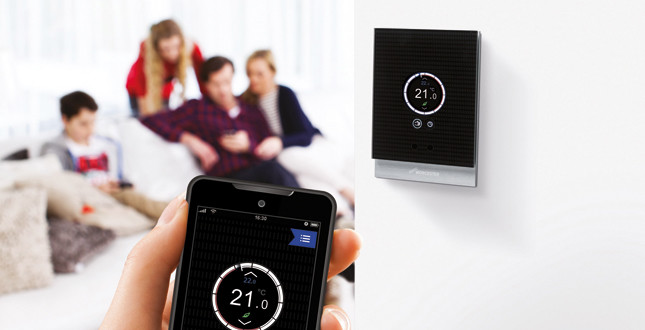

Reporting for HVP, Kevin Stanley spoke to manufacturers to identify the drivers behind the shift from the dull, grey thermostat on the wall to more modern, stylish, wireless controls.
In recent years, there has been a surge of interest in heating controls, and, subsequently, huge investment from manufacturers into development. Advances in technology, such as touchscreen products, have also changed the way we interact with the world around us.
Martyn Bridges, Director of Technical Communication and Product Management at Worcester, Bosch Group, says that smartphones have made users much more familiar with touchscreens.
“Previously, consumers may have only felt comfortable with physical buttons and dials, but now they’re open to intuitive options, such as where the heating can be controlled using a touch screen or via an app on their phone,” he said.
The emergence of third-party control companies developing products with enhanced style and aesthetics has led boiler manufacturers to react and offer devices with similar visual impact and functionality. Subsequently, aesthetic trends are moving towards the use of premium materials that are more tactile and visually appealing than the traditional grey or cream plastic wall-mounted thermostats.
Alex Boweren, Product Manager at Ariston, says that controls are increasingly being manufactured using high quality plastics, metals and even glass. Digital displays have also developed significantly in recent years in terms of both form and usability.
“They now have larger, higher quality screens with menu systems laid out in a similar fashion to other smart devices – all of which makes them simpler to use,” he said.
WiFi, and widespread easy internet connectivity, means that users don’t even need to be home to set their heating systems.
“They can do it remotely from their smartphones,” Alex said. “This functionality, coupled with time scheduling and advanced programming options, has allowed controls to become an integral part of the modern home.”
The main driver behind the evolution of heating controls is their energy saving capabilities. This is important for consumers in terms of fuel savings and stems from regulations to reduce fuel usage and meet carbon reduction targets.
“Energy Related Products and Energy Labelling regulations stipulate the necessary requirements heating systems must meet in terms of efficiency,” said Alex. “Controls must adhere to these regulations, otherwise they cannot be sold.”
Boiler Plus will also come into force on 6 April 2018 as part of the government’s Clean Growth Strategy, aimed at cutting carbon emissions to combat climate change, while driving economic growth.
Under the requirements of Boiler Plus, every replacement gas boiler installation in England will need to be accompanied by working time and temperature controls, plus at least one of the following additional measures – load compensation, weather compensation, a flue gas heat recovery unit, or a smart thermostat with automation and optimisation.
Options for compliance
Martyn explains how installers can begin to comply: “Many of the latest heating controls are already equipped with two or more of the functions needed to comply with Heat in Buildings. Worcester’s Comfort I or Comfort II device will provide time and temperature control, along with load compensation, making it relatively easy to not only meet, but exceed, the latest requirements.”
There are, however, still millions of properties around the country that have no form of heating control installed, and the industry has a role to play in increasing the adoption of minimum standard controls.
“It shouldn’t be forgotten that the most effective control will always be one that is understood and used to its full potential by the homeowner. There are simpler and more affordable options that meet these requirements,” Martyn explained.
Paul Haynes, Head of PRO, EMEA, at Nest, agreed: “Despite adding more functions, we have ensured that things remain simple, and that our controls are intuitive for everyone in the household. The Nest Learning Thermostat uses a feature called FarSight to adapt to the user – showing different information depending on the location of the user, or simply turning off altogether.”
Advanced controls can also work in tandem with smoke and carbon monoxide alarms to improve home safety. Installers can educate consumers about how connected heating controls can interact with broader smart home products – creating a huge opportunity for them to up-sell from an initial connected home purchase, such as a thermostat.
Paul explains that, by making customers aware of new technologies, it will help them understand that their systems can do more.
He said: “Nest’s mission is to transform these unloved, but important, devices in your home into thoughtful products that do more for you than you do for them.
“By incorporating technologies such as machine learning and OpenTherm, and connecting them with your smartphone, we’re able to reinvent the way you interact with these devices and deliver improved energy efficiencies, safety and comfort.”
If you'd like to keep up-to-date with the latest developments in the heating and plumbing industry, why not subscribe to our weekly newsletters? Just click the button below and you can ensure all the latest industry news and new product information lands in your inbox every week.